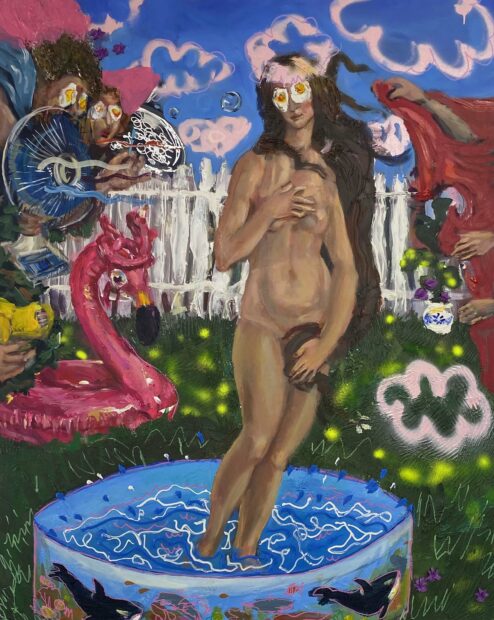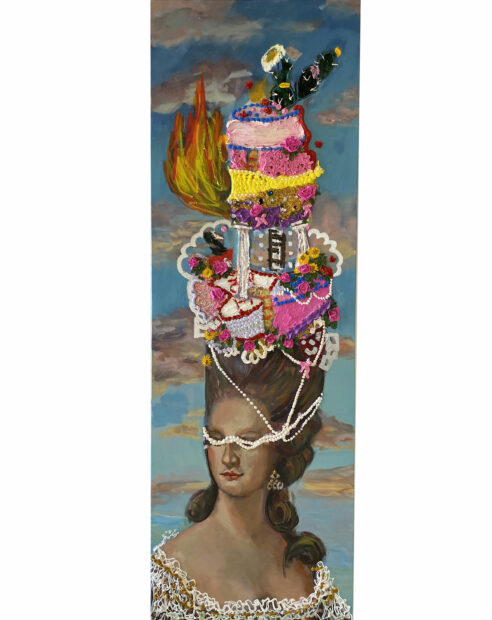
Ana Laura Hernández, “Day 456 of Quarantine,” 2021, acrylic, oil and pastel on canvas, 48 x 60 inches.
Laredo might not be the place where people drop by to view art…or is it? It’s a city known for commerce and international trade, where four land bridges connect the U.S. with Mexico over the Rio Grande. Laredo is a major inland port in the U.S. where interstate highway I-35 begins its long stretch northbound across the country. Over 14,000 loaded semi-trailer trucks make their way north from Mexico, across Laredo, and onto I-35 on a daily basis, meaning most visits to the city are transitory and business related. However, we’re not locked in traffic here, like most Texas cities. The landscape is not an elaborate metropolis; it’s hot most of the year, and many of us have experienced some sort of culture shock at some point.
People in Laredo thrive on togetherness. Family and traditions make the city a tight-knit community. The people who live here, or have lived here, occupy interstices. They exist in an “in between,” as most border people do. Laredoans are in a unique disposition because everything here exists that way — in the middle, neither here, nor there — and we, most of us, know how to exist on both sides of whatever it is we’re stuck in between. Nonetheless, this city does produce artists, and there are spaces that foster language for and about art.
Laredo native Ana Laura Hernández’s solo-exhibition Code-Switching is currently on view at the Laredo Center for the Arts, a historic building located in the heart of downtown, just a few blocks away from two major international land bridges. The exhibition includes over forty works in different painting techniques and processes. The artist’s pieces welcome a multitude of conversations surrounding fancy, ornate women in big dresses with big hair topped with pastries with overflowing icing, embellished pets, chickens and eggs — lots of eggs — bananas, and cacti, among other iconographies. The dialogue in the work alternates between popular culture from both sides of the border.
Code-switching (the term and concept) is about interchange; it’s a back-and-forth between different languages. Hernández’s show offers alternations not just between language (as some of the titles of her work are solely in Spanish), but also in her visual representations of expressions and colloquialisms, and between the language of norteños (northern Mexicans), Spanglish, and the language of art. One can see where she draws inspiration. Some of the references I picked up on include characters from the Golden Age of Mexican cinema, classical art, Frida Kahlo, Sandro Botticelli, and imagery found in Rococo paintings. Her works in the exhibition are personal, other worldly, nonsensical, and humorous.
Walking into the main gallery at the Laredo Center for the Arts, the viewer is presented with three paintings that reference major popular culture iconography: Venus, classical statues, and Marie Antoinette.
In her painting Day 456 of Quarantine, Hernández presents a woman portrayed as Venus, the goddess of love and beauty, wearing sunny side up eggs (or perhaps fried eggs?) over her eyes as she stands in a plastic kiddie pool decorated with the iconic orca whales found at San Antonio’s SeaWorld. She is surrounded by the angels that led her to where she is: on a lawn inside a white picket fence, with a large flamingo pool floatie behind her. The angels above and to the left of her, floating in the air, also have eggs covering their eyes. One is holding a vintage blue electric fan, blowing air towards the Venus figure, and the other is blowing bubbles.
It’s a humorous scene that comes together with floating clouds drawn in pink lines over Venus’ head next to a beautiful clear, blue sky. The colors are bright and vivid and there is an array of texture presented by Hernández’s use of paint, pastels, and spray paint, which gives the work an urban feel. The context of the work is very specifically set to the COVID-19 pandemic, and the titles reference the days of quarantine the artist experienced. The piece is also an example of how many got creative after being in isolation for such a long period of time. This work sets the tone for the rest of the show.

Ana Laura Hernández, “The Higher the Hair the Closer to Heaven,” 2022, acrylic and oil on canvas, 24 x 62 inches.
Many of the works in the show are representations of women from another era and place, like 18th century France (as exemplified by their large ornate dresses and big hair). In the painting The Higher the Hair the Closer to Heaven, a woman poses in front of a sky scape. Her hair is tall and large, but her headdress stands shockingly taller. It is composed of what appears to be a two-tier pastry display stand which stacked with slices of desserts, flowers, and crowned by a four-layer cake topped with a cactus which is then topped by a fried egg. Decorative pearls dangle over the woman’s face, creating hip, if impractical, eyewear. On top of everything, there is a fire off to the left side of her headdress which perhaps was started by an unattended candle. The woman is very calm in this scenario; the work brings about the idea that women are to remain submissive and pretty at all times, especially when they are the muse for a portrait.
However, not all the women who are represented in the exhibition follow this demeanor. Untitled (A HUEVO) is a work that portrays a woman similar to the main character of Maria Candelaria, a film from the Golden Age of Mexican cinema, about an indigenous woman from Xochimilco who is shunned for being the daughter of a prostitute. In the painting, Hernandez illustrates the woman sitting angled to the right, facing the viewer, in front of a landscape with a river. She is holding a rooster on her lap, and has a hot pink shawl draped around her. Her eyes are covered by a slather of textured hot pink matte paint, and she’s wearing a traditional crown made out of red flowers that spell out “A HUEVO.” The flowers, text, and embroidery elements on the woman’s clothing are created using thick, high-gloss paint applied with the same icing piping tips used in cake decorating. Fried eggs float on the river in the background, and multicolor circles consume the bottom of the work and diminish in clusters as they approach the top of the painting. The expression “a huevo” roughly translates to “hell yeah,” but is used in different ways depending on the context and the intensity of a conversation (“huevo” translates to “egg,” and “a huevo” directly is “to egg”). In this case, though, the woman appears to be calm and is declaring her power just by being who she is in that moment: a badass unapologetically holding a rooster on her lap. Her crown, topped with the expression, shows she is in control of the situation. The piece also references cockfighting, which has a long, controversial history in Mexican and border culture.

Ana Laura Hernández, detail from “Untitled (A HUEVO),” 2022, acrylic, oil and gold leaf on wood panel, 48 x 60 inches.
I wouldn’t say Code-Switching is about female empowerment or a direct critique about gender roles. As the show progresses, the viewer is confronted with common, everyday situations and personal and human conditions. There are works that directly relate to nostalgia and capture moments important to the artist’s life and those she cares for. Some of the works appear chaotic because of Hernández’s intertwined use of colors, textures and loose strokes. However, there is a delicate balance in the way the artist approaches creating work in today’s world, in a frame of code-switching and alternating in the interstices, and in her paintings, in which she captures those nostalgic moments as “de color de rosa” (the color pink, pretty in pink).
Code-Switching is on view at the Laredo Center for the Arts until April 1, 2022



1 comment
Bravo. Excellent review, Maritza!